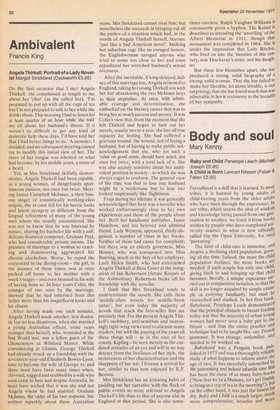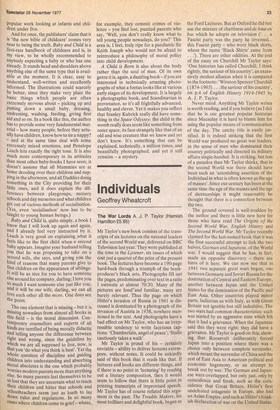Body and soul
Mary Kenny
Baby and Child Penelope Leach (Michael Joseph £6.95) A Child is Born Lennart Nilsson (Faber & Faber £2.95) Parenthood is a skill that is learned. In most tribes, it is learned by young adults of child-bearing years from the older adults who have been through the experience. Iii our tribe, which scorns the idea of wisdom and knowledge being passed from one generation to another, we learn it from books written by people who have completed university courses in what is now officiallY called (by the Open University, for one) 'parenting'. The field of child-care, is immense, and despite a declining child ,population, groWing all the time. Indeed, the more the child population declines, the more books are needed: if each couple has only one child, giving birth to and bringing up that child becomes, literally, a unique experience carred out in comparative isolation, so that the skill is no longer acquired by simple exarri" pie or everyday familiarity, but must be researched and studied. In her first book, Babyhood, Penelope Leach demonstrated that the principal obstacle to breast-feeding today was that the majority of urban young women had never seen a baby put to the breast — and thus the entire practice and technique had to be taught like, say. French grammar. It was strange, unfamiliar, and needed to be worked on.
Babyhood was a Penguin book PO' lished in 1975 and was a thoroughly reliable study of what happens to infants under the age of two. It was mercifully untouched bY the patronising and indeed infantile tone that has been the curse of so many baby-books ('Now that we're a Mtimmy, let's get DaddY to bring us a cup of tea in the morning!') , ht.!t on the other hand, it was just the tiniest bit dry. Baby and Child is a much larger, much more comprehensive, broader and more Popular work looking at infants and children under five.
And for once, the publishers' claim that it IS 'the new bible of childcare' comes very near to being the truth. Baby and Child is a first-rate handbook of childcare and is, in my view, to be wholly recommended to anybody expecting a baby or who has one already. It stands head and shoulders above anything else of the same type that is available at the moment. It is clear, easy to understand, well-written and excellently informed. The illustrations could scarcely be better, since they make very plain the basic things which people are often extremely nervous about — picking up and Putting down a small baby, dressing, undressing, washing, feeding, giving first aid and so on. In a book like this, the author has to provide some very fundamental material — how many people, before they actually have children, know how to tie a nappy? — and at the same time deal with some extremely mixed emotions, and Penelope Leach hits exactly the right tone. It is also much more contemporary in its attitudes than most other baby-books I have seen; it doesn't assume that all Mummies are at home drooling over their children and napPine in the afternoon, and all Daddies doing something in the City providing for their little ones, and it does explain the differences between playgroups, nursery schools and day nurseries and what children get out of various methods of socialisation. (Yes, even 'socialisation' now has to be taught to young human beings.) Baby and Child is, quite simply, a book I know that I will look up again and again, and I already feel very instructed by it. Leach is very good on explaining what it feels like to the first child when a second baby appears. Imagine your husband telling You that he was proposing to take on a second wife, she says, and giving you the kind of reasons that many parents give to first children on the appearance of siblings: It will be so nice for you to have someone else around for company, darling; I love you SO much I want someone else just like you; and it will be our wife, darling, we can all love each other all the more. One does see the point.
The one element that is missing but it is missing nowadays from almost all books in this field — is the moral dimension. Contemporary counsellors and experts of all kinds are terrified of being morally didactic and telling anyone the difference between right and wrong, since the guideline by Which we are all supposed to live, now, is that you 'do what you think is best', Yet the Whole question of discipline and guiding children into understanding and absorbing moral absolutes is the one which probably worries modern parents more than anything else. So many parents feel themselves to be SO lost that they are uncertain what to teach their children and bitter that schools and schoolteachers seem just as loath to lay down rules and regulations. In so many cases where children come to grief where, for example, they commit crimes of violence — you find lost, puzzled parents who say, 'Well, you don't really know what to tell young people nowadays, do you?' This area is, I feel, truly ripe for a paediatric Sir Keith Joseph who would not be afraid to reintroduce a philosophy of moral policy into child development.
A Child is Born is also about the body rather than the soul of man. Of its own genre it is, again, a dazzling book if you are interested in technically amazing photographs of what a foetus looks like at various early stages of its development. It is largely a photographic book, and Scandinavian in provenance, so it's all frightfully advanced, healthy and clever. Yet it makes you reflect that Stanley Kubrick really did have something in the Space Odyssey: the child in the womb really does seem like something from outer space, its face strangely like that of an old and wise 'creature that we know and yet don't know. It's something that can be explained, technically, a million times, and beautifully photographed, and yet it still remains — a mystery.







































 Previous page
Previous page